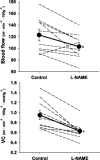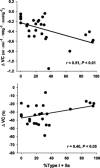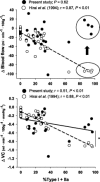Nitric oxide synthase inhibition during treadmill exercise reveals fiber-type specific vascular control in the rat hindlimb
- PMID: 20007515
- PMCID: PMC2828181
- DOI: 10.1152/ajpregu.00631.2009
Nitric oxide synthase inhibition during treadmill exercise reveals fiber-type specific vascular control in the rat hindlimb
Erratum in
- Am J Physiol Regul Integr Comp Physiol. 2010 Mar;298(3):R849
Abstract
The control of vascular tone during exercise is highly complex and integrated. Specifically, in regards to the contribution of nitric oxide (NO), the observed magnitude and muscle fiber-type dependency of the NO contribution to exercise hyperemia may differ depending on the timing of NO synthase (NOS) inhibition with respect to the exercise bout (i.e., administration prior to vs. during exercise). We tested the hypothesis that, in the presence of prior cyclooxygenase inhibition (indomethacin, 5 mg/kg(-1)), NOS inhibition (N(G)-nitro-L-arginine methyl ester, L-NAME; 10 mg/kg) administered during submaximal treadmill exercise would blunt blood flow and vascular conductance (VC) in the hindlimb muscle(s) of the rat with the greatest reductions in blood flow and VC occurring in the predominantly oxidative muscles. Adult female Wistar rats (n = 10, age: 3-4 mo) ran on a motor-driven treadmill (20 m/min, 10% grade). Total and regional hindlimb muscle blood flow and VC were determined via radiolabeled microspheres before (control) and after L-NAME administration during exercise. L-NAME reduced (P < 0.05) total hindlimb muscle blood flow (control: 123 + or - 10, L-NAME: 103 + or - 7 ml x min(-1) x 100g(-1)) and VC (control: 0.95 + or - 0.09, L-NAME: 0.63 + or - 0.05 ml x min(-1) x 100g(-1) x mmHg(-1)). There was a significant correlation (r = 0.51, P < 0.05) between the absolute reductions in VC after L-NAME and the percent sum of type I and IIa fibers in the individual muscles and muscle parts; however, there was no correlation (P = 0.62) when expressed as blood flow. Surprisingly, the highly oxidative muscles demonstrated a marked ability to maintain oxygen delivery, which differs substantially from previous reports of L-NAME infusion prior to exercise in these muscles. The demonstration that NO is an important regulator of blood flow and VC in the rat hindlimb during treadmill exercise, but that the fiber-type dependency of NO is altered markedly when NOS inhibition is performed during, vs. prior to, exercise, lends important insights into the integrated nature of vascular control during exercise.
Figures







Similar articles
-
Effects of neuronal nitric oxide synthase inhibition on resting and exercising hindlimb muscle blood flow in the rat.J Physiol. 2010 Apr 15;588(Pt 8):1321-31. doi: 10.1113/jphysiol.2009.183723. Epub 2010 Feb 22. J Physiol. 2010. PMID: 20176629 Free PMC article.
-
Aging alters the contribution of nitric oxide to regional muscle hemodynamic control at rest and during exercise in rats.J Appl Physiol (1985). 2011 Oct;111(4):989-98. doi: 10.1152/japplphysiol.00490.2011. Epub 2011 Jul 14. J Appl Physiol (1985). 2011. PMID: 21757576
-
Effects of nitric oxide synthase inhibition on vascular conductance during high speed treadmill exercise in rats.Exp Physiol. 2001 Nov;86(6):749-57. doi: 10.1111/j.1469-445x.2001.tb00040.x. Exp Physiol. 2001. PMID: 11698969
-
Acute antioxidant supplementation and skeletal muscle vascular conductance in aged rats: role of exercise and fiber type.Am J Physiol Heart Circ Physiol. 2011 Apr;300(4):H1536-44. doi: 10.1152/ajpheart.01082.2010. Epub 2011 Jan 14. Am J Physiol Heart Circ Physiol. 2011. PMID: 21239634
-
Skeletal Muscle Vascular Control During Exercise: Impact of Nitrite Infusion During Nitric Oxide Synthase Inhibition in Healthy Rats.J Cardiovasc Pharmacol Ther. 2016 Mar;21(2):201-8. doi: 10.1177/1074248415599061. Epub 2015 Aug 12. J Cardiovasc Pharmacol Ther. 2016. PMID: 26272082
Cited by
-
Critical speed in the rat: implications for hindlimb muscle blood flow distribution and fibre recruitment.J Physiol. 2010 Dec 15;588(Pt 24):5077-87. doi: 10.1113/jphysiol.2010.198382. Epub 2010 Oct 20. J Physiol. 2010. PMID: 20962004 Free PMC article.
-
Regulation of increased blood flow (hyperemia) to muscles during exercise: a hierarchy of competing physiological needs.Physiol Rev. 2015 Apr;95(2):549-601. doi: 10.1152/physrev.00035.2013. Physiol Rev. 2015. PMID: 25834232 Free PMC article. Review.
-
The effect of nitric oxide synthase inhibition with and without inhibition of prostaglandins on blood flow in different human skeletal muscles.Eur J Appl Physiol. 2017 Jun;117(6):1175-1180. doi: 10.1007/s00421-017-3604-2. Epub 2017 Apr 21. Eur J Appl Physiol. 2017. PMID: 28432421
-
Effects of neuronal nitric oxide synthase inhibition on resting and exercising hindlimb muscle blood flow in the rat.J Physiol. 2010 Apr 15;588(Pt 8):1321-31. doi: 10.1113/jphysiol.2009.183723. Epub 2010 Feb 22. J Physiol. 2010. PMID: 20176629 Free PMC article.
-
KATP channels and NO dilate redundantly intramuscular arterioles during electrical stimulation of the skeletal muscle in mice.Pflugers Arch. 2021 Nov;473(11):1795-1806. doi: 10.1007/s00424-021-02607-1. Epub 2021 Aug 13. Pflugers Arch. 2021. PMID: 34386847 Free PMC article.
References
-
- Armstrong RB, Laughlin MH. Metabolic indicators of fibre recruitment in mammalian muscles during locomotion. J Exp Biol 115: 201–213, 1985 - PubMed
-
- Clifford PS, Hellsten Y. Vasodilatory mechanisms in contracting skeletal muscle. J Appl Physiol 97: 393–403, 2004 - PubMed
-
- Delp MD, Duan C. Composition and size of type I, IIA, IID/X, and IIB fibers and citrate synthase activity of rat muscle. J Appl Physiol 80: 261–270, 1996 - PubMed
-
- Delp MD, Laughlin MH. Regulation of skeletal muscle perfusion during exercise. Acta Physiol Scand 162: 411–419, 1998 - PubMed
Publication types
MeSH terms
Substances
Grants and funding
LinkOut - more resources
Full Text Sources
Miscellaneous

